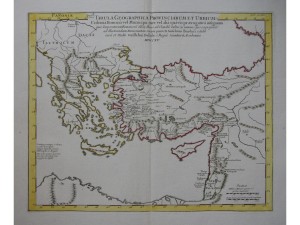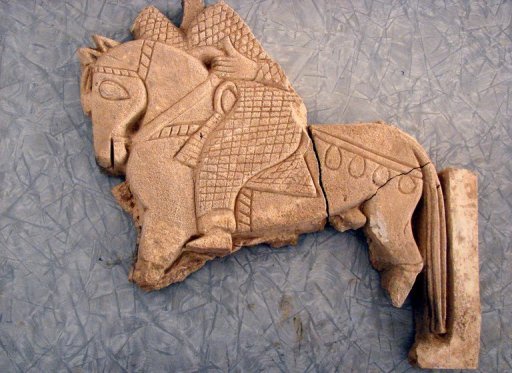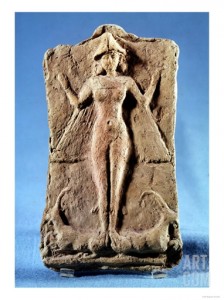Early History
Until the 20th century the term Syria generally denoted those lands of the Levant, or eastern littoral of the Mediterranean, that correspond to modern Syria and Lebanon, most of Israel and Jordan, West Iraq, and North Saudi Arabia. Three geographical factors have played major parts in determining the history of Syria—its location on the trade and military routes, its varied topography, and the encroaching desert. Syria has always been an object of conquest, and it has been held by foreign powers during much of its history.
Plaque of a Winged Goddess, Possibly Ishtar, Standing on Two Ibexes, from Ras Shamra (Ugarit)
One of the earliest settlements was probably at Ugarit; human habitation at Tell Hamoukar in NE Syria dates to at least 4000 B.C. The Amorites, coming c.2100 B.C. from the Arabian peninsula, were the first important Semitic people to settle in the region, and they established many small states.
From the 15th to the 13th century B.C. the area probably was part of the empire of the Hittites, although it came under Egyptian rule for long periods during that time. The first great indigenous culture was that of Phoenicia (located mostly in present-day Lebanon), which flourished after 1250 B.C. in a group of trading cities along the coast. In the 10th cent. B.C. two Hebrew kingdoms were organized in Palestine (see also Jews). Syria suffered (11th–6th cent. B.C.) long invasions and intermittent control by the empire of Assyria. Babylonian conquerors also found success in Syria, and Egypt constantly sought to reestablish its position there. The Syrians were subjected to massacres, plundering, and forced deportations.
Under the Persian Empire, with its efficient administrative system, Syria’s standard of living improved (6th–4th cent. B.C.). Alexander the Great conquered Syria between 333 and 331 B.C., and his short-lived empire was followed by that of the Seleucidae (see Seleucus I), who are usually called kings of Syria. Their control of Syria was constantly threatened by Egypt, which was ruled by the Ptolemies.
 Classical Roman antique map, Turkey Greece Syria Delisle 1715
Classical Roman antique map, Turkey Greece Syria Delisle 1715
The Egyptians usually held the south until Antiochus III conquered (early 2d cent. B.C.) the region, which was generally called Coele Syria, a name which had been vaguely applied to all of W Syria. The Seleucids founded cities and military colonies and introduced Hellenistic civilization to Syria. Syria long showed the revivifying effects of this new culture. Many of the cities became cultural Hellenistic centers, but the change did not reach the lower levels of the population.
When invasions began again, first by the Armenians under Tigranes and then by the Parthians—both in the 1st cent. B.C.—the Hellenistic sheen was soon dulled. The Romans under Pompey conquered the region by 63 B.C., but they continued to fight the Parthians there, and the Syrians benefited little from the Roman presence. Many changes in administration occurred, and Rome drew from Syria numerous soldiers and slaves. The old pagan gods of Syria were also taken up by the Romans. More significant for the future of Syria, Christianity was started in Palestine and soon exerted some influence over all of Syria; St. Paul was converted from Judaism to Christianity on the road to Damascus. In central Syria, Palmyra grew (3d cent. A.D.) to considerable power as an autonomous state, but it was conquered by the Romans when it threatened their ascendancy.
 A sculpture of a knight riding a horse which dates back to the Ummayad period (Palmyra Antiquities Department)
A sculpture of a knight riding a horse which dates back to the Ummayad period (Palmyra Antiquities Department)
After the division of Rome into the Eastern and Western empires in the 4th cent., Syria came under Byzantine rule. In the 5th and 6th cent. Monophysitism, a Christian heresy with political overtones, gained many adherents in Syria. Byzantine control there was seriously weakened by the 7th cent. Between 633 and 640, Muslim Arabs conquered Syria, and during the following centuries most Syrians converted to Islam. Damascus was the usual capital of the Umayyad caliph (661–750) and enjoyed a period of great splendor. The Umayyads were forcibly displaced by the Abbasids, whose residence was in Iraq, thus ending Syria’s dominant position in the Islamic world. At the same time the ties between Muslim Syria and the predominantly Christian southwest (later Lebanon) began to loosen.
Resource
Syria: History in ‘The Columbia Electronic Encyclopedia,’ 6th ed. 2012 at Infoplease.com

